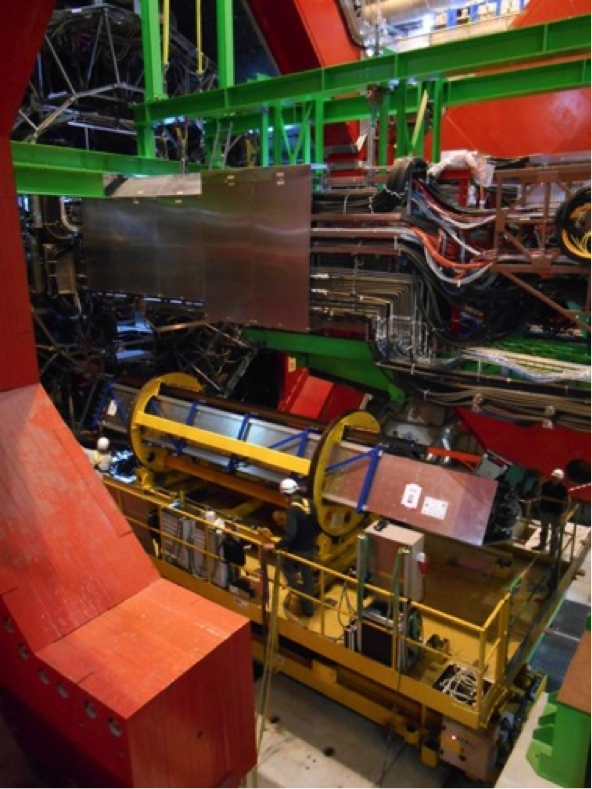ALICE looking into the future
Following a busy year, ALICE is now almost ready for the next run, as the teams make finishing touches before turning their focus towards re-commissioning and calibration. Thanks to the upgrades of the past year, Run2 will provide another in–depth look at the physics of the quark-gluon plasma, with the higher-energy collisions and higher collision rates, allowing ALICE to dig deeper and explore further.
The final three modules of the Dijet Calorimeter (DCAL), the most significant addition to the ALICE detector in 2013, were installed this fall. They completed the 60 degree calorimeter extension of the EMCAL detector that is set opposite the present calorimeter, covering 120 degrees of polar angle.

Happy smiles - the DCAL and Technical Coordination team after the successful completion of the calorimeter.
In November, the last Transition Radiation Detector (TRD) modules were installed above the beam line: they were the final pieces to go into the detector before the magnet doors closed. Three modules were installed successfully already in May below the beam line: a difficult task, considering that the location required dismantling major parts of the service structure. The TRD consists of 18 sectors, like the other central barrel detectors. During Run1, 13 modules were already installed, but the full implementation was scheduled for LS1.

A TRD module being inserted into the ALICE detector, while the service support structure, the so called Miniframe, is hanging from a temporary support (top).
As the data acquisition needs of ALICE will be increased in Run 2, upgrades to the DAQ system were necessary. The readout rate reaches 1kHz, meaning that one in ten events in the future Pb-Pb collisions will be selected by a set of trigger conditions and saved for analysis. The online software was also improved to allow for maximum operational efficiency. The system can now be engaged much faster than before and perform automatic detector recovery in the event of an electronics hiccup or high voltage trip. As a result, the possibility of common errors inhibiting data acquisition should be reduced.
ALICE has also benefited by improvements to the LHC. Several sections of the vacuum pipe were NEG coated and the injection protection collimators (TDI) were refurbished during the LS1, improving the quality of the vacuum around the interaction point. The potential background in ALICE should, therefore, be reduced, as there will be fewer beam-gas interactions.
In addition to these upgrades, the ALICE Run Control Centre (ARC) was renovated in 2013. The new room can now accommodate comfortably the main operators, as well as detector experts and the Run Coordination team. Moreover, it includes a meeting area, for the coordinators to get together, and an access ramp, for persons with reduced mobility. Three windows have also been opened, one of which will become a “magic window”. It will enhance the visitors's experience by turning into a touch screen, where the guides will run interactive presentations.

The new ALICE Run Control Centre.
Presently, a significant fraction of the 19 subsystems are already up and running, and ALICE received the first ‘splashes’ of muons during the tests of the LHC transfer lines. For the first time since February 2013, the SPS to LHC transfer lines (TI8 and TI2) transported proton beams just short of the LHC. These LHC tests are used by ALICE for time alignment of the different detector systems.
The ALICE solenoid, the so called L3 magnet, has been successfully re-commissioned, which will allow an extended cosmic run during January and February of 2015 in preparation for Run2.
The ALICE collaboration is in good health and pursuing with unwavering enthusiasm its exploration of the mysteries of the QCD phase transitions, in a scientific programme that will extend well into the next decade.
